=================================================================
To subscribe, unsubscribe or change your email address, visit:
http://www.imaging-resource.com/IRNEWS/index-subs.html
Support the Newsletter!
- Find the best price for anything at http://ir.pricegrabber.com
- Shop Amazon, Adorama at http://www.imaging-resource.com/buynow.htm
=====================================================
THE IMAGING RESOURCE DIGITAL PHOTOGRAPHY NEWSLETTER
=====================================================
Volume 15, Number 21 - 18 October 2013
----------------------------------------------------------------------
Copyright 2013, The Imaging Resource. All rights reserved.
----------------------------------------------------------------------
Welcome to the 370th edition of The Imaging Resource Newsletter. In this issue, we feature our first impressions on several cameras that were introduced in the past two weeks, including groundbreaking new models such as the full-frame mirrorless Sony A7 (and A7R), the truly micro Micro Four Thirds Panasonic GM1, and the Pentax K-3 DSLR with its innovative switchable low-pass filter. We also serve up an excerpt from our review of the Sony RX1R, in which we perform a detailed analysis of its JPEG and RAW images against those from the original RX1, and feature an article about how you can get your next photo project funded by crowdsourcing it online. Finally, Dave Etchells answers a ton of reader mail, and asks for your feedback on how we might do a better job covering consumer digicams. There's a lot to read, so time to dig in!
TOPICS
----------
Get Social with IR
Sponsors
Camera Review: Sony RX1R Shooter's Report (Excerpt)
Feature: How to Get Your Photo Project Funded by Crowdsourcing on Kickstarter
Camera Preview Roundup: Pentax K-3, Sony A7, Nikon D5300, Panasonic GM1 and more
We've Got Mail
Next Issue
Signoff
GET SOCIAL WITH IR
---------------------------
If you want to stay up-to-date with the latest camera and photography news, get notified when IR posts its latest camera or lens review, and much more, please get social with us on your favorite networking sites by:
By doing so, you'll also be supporting our efforts to deliver the best camera and photography content on the planet. (Google in particular apparently pays lots of attention to Google+ in deciding site/page relevance for its search results, so "circling" us there and +1-ing our site and pages would be an especially big help.) Thanks! We appreciate it!
SPONSORS
--------------
This issue is sponsored in part by the following companies. Please show your appreciation by visiting the links below. (Visiting our sponsor's links really helps support this newsletter, thank you for your attention!) And now a word from our sponsors:

* Olympus *
Introducing a camera as revolutionary as you are.
The Olympus OM-D E-M1
Take incredible images anywhere you go.
Move into a new world
Re-imagined
Redesigned
Revolutionized
See for yourself: http://www.imaging-resource.com/cgi-bin/nl/pl.cgi?olyfz1
* Sigma *
Sigma's new Global Vision lenses feature the latest technology
and combine optical performance resulting in a tour de force
that meets all of your photographic needs.
Our new lenses include the new
35mm F1.4 DG HSM 'Art',
17-70mm F2.8-4 DC Macro OS HSM 'Contemporary' and
120-300mm F2.8 DG OS HSM 'Sport'.
Our cameras, featuring the Foveon X3 sensor, include the SD1 and the
DP Merrill, produce the highest quality digital images.
Learn more about Sigma offerings at http://www.imaging-resource.com/cgi-bin/nl/pl.cgi?sg13
-----------------------------------------------------------------------------------------------------
Are you in the digital photo business? This newsletter is read by more than 47,000 direct subscribers (plus additional pass-along readers), all with a passion for digital photography. For information on how you can reach them, contact us at editor@imaging-resource.com.
-----------------------------------------------------------------------------------------------------
REVIEW: Sony RX1R Shooter's Report (Excerpt)
-----------
(Check out our full Sony RX1R review, featuring our ultimate conclusion: http://www.imaging-resource.com/PRODS/sony-rx1r/sony-rx1rA.HTM)
by William Brawley
There's nothing much new to say about the Sony RX1R enthusiast, fixed-focal-length-lens compact camera in terms of its usability. If you've shot with an RX1, then for all intents and purposes you've shot with an RX1R. This is good news, given how much we liked the flexibility of the RX1's user interface and its various features. (Read our RX1 review to learn why.) The only difference between these two models is that Sony removed the optical low-pass filter on the new model and improved the JPEG processing. The RX1R features the same compact, high-quality metal body and the sharp Zeiss 35mm f/2 fixed lens as its filtered fraternal twin. Operationally, these two cameras are identical and cosmetically as well, except for that painted red "R" on the front of the RX1R in addition to the mod
el name change on the back.
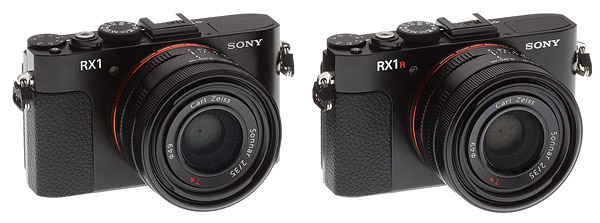
Doing away with the optical low-pass filter (OLPF) on the RX1R does produce sharper, more detailed images, although the difference is less evident in its RAW files than most people will perhaps be expecting. We've seen other manufacturers offer two versions of the same camera, with and without the OLPF, and charge more for the filter-less version. Sony is allowing customers to choose the best camera for their needs by offering the RX1R at the same price as the RX1, which we think is a smart move.
 |
The Sony RX1R's full-frame sensor and 35mm Carl Zeiss f/2 lens make a great combo for sharp and vibrantly colored photos. |
Design. In the hand, the RX1R is a very solid camera with excellent build quality. Like the RX1, it's very impressive that Sony managed to cram a 35mm full-frame CMOS sensor into such a small body, and it makes the RX1 and RX1R a pair of very unique cameras. These two Sony models produce stunningly high quality images in a very portable form factor, all for a fraction of the cost of a Leica M. While the RX1/RX1R isn't exactly pocketable in the truest sense of the word, you can still stash it away safely in a jacket.
Lens and operation. The fast f/2 Zeiss lens is impressive optically, and thanks to the large sensor and wide f/2 aperture, the RX1R performs phenomenally well in low-light scenarios, as well as creates fantastic shallow depth-of-field imagery. As we saw in the RX1, the (semi-)manual aperture ring is a cool touch that gives the RX1R a bit of a retro edge. I say semi-manual because the aperture can also be electronically controlled by the camera when in other exposure modes such as Program Auto or Shutter Priority (in those modes, the aperture ring does not change the aperture).
 |
Performance. The autofocusing performance of the RX1R is overall excellent. In good lighting or with higher contrast subjects, the RX1R can lock focus very quickly -- even when racking from near to far subjects. Also, when focusing and re-focusing on similar subjects at similar distances, the RX1R proved to be lightning quick. I did find, however, that it can be a bit on the sluggish side and prone to hunting when autofocusing on lower-contrast subjects.
Use. Given its small size, sturdy build quality and excellent image quality and large print sizes, the RX1R is an ideal travel and hiking camera for fans of street and travel photography, as well as for landscapes. If you can live with the single focal length (forcing you to "zoom with your feet"), I definitely see the RX1R as a worthy DSLR alternative -- and easily as a second camera (albeit an expensive one!) for everyday shooting.
 |
The compact size and fast, wide-angle lens makes the Sony RX1R perfect camera for street shooters and those simply looking to carry a high-quality camera with them at all times. |
More moir�. While shooting with the RX1R should allow you to produce some strikingly sharp photos, there is one major downside to the lack of an OLPF: moir�. As expected, the RX1R shows an obvious increase in moir� and aliasing artifacts over the RX1. Users of cameras like the RX1R should be careful shooting certain subjects such as finely-patterned fabrics, metal mesh grates and tables, or windows screens.
Interestingly, the effect of moir� is much more noticeable in RAW images compared to in-camera JPEGs. We were rather impressed by the JPEG processing of the RX1R and its ability to almost completely remove moir� in many situations, although you're absolutely going to encounter it sooner or later. In the table below, we compare the moir� effects of the RX1R against the RX1, as well as point out the differences between RAW (processed through Adobe Camera Raw, with no sharpening or noise reduction applied) and in-camera JPEG files.
Sony RX1R vs RX1: Moir� |
RX1R |
RX1 |
 |
 |
|
|
 |
 |
100% Crop - RAW |
100% Crop - RAW |
 |
 |
100% Crop - JPEG |
100% Crop - JPEG |
 |
 |
|
|
 |
 |
100% Crop - RAW |
100% Crop - RAW |
 |
 |
100% Crop - JPEG |
100% Crop - JPEG |
In both of these comparisons, it's easy to see that the lack of an optical low-pass filter in the RX1R increases the presence of moir�, however the RX1 still produces a fair amount itself. It's also worth noting that the in-camera JPEG processing of both cameras is able to significantly reduce, or very nearly eliminate the moir�, at least with these particular subjects. |
Stellar JPEGs. As you may know, we loved the Sony RX1 so much we named it our 2012 Camera of the Year. (In fact, it's one of our all-time favorite cameras, out of all we've reviewed.) And any claims of improvement to such an awesome photographic tool commanded our full attention.
Our lab test shots and real-world gallery images show astounding differences between the JPEG image quality of the RX1R and RX1 The RX1R demonstrated dramatically more sharpness and detail.
| Sony RX1R - Image quality comparisons vs. Sony RX1 at base ISO |
| In-camera JPEG |
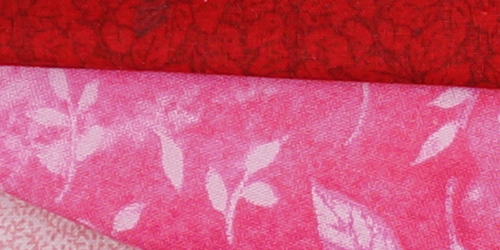 |
| Sony RX1 at ISO 100 (JPEG) |
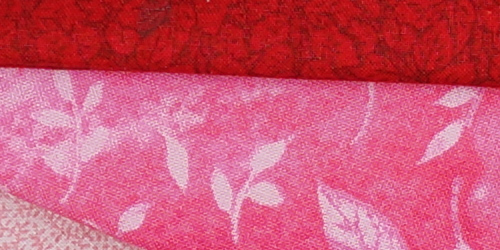 |
| Sony RX1R at ISO 100 (JPEG) |
While there seems to be a bigger sharpness increase from the removal of the RX1's low-pass filter than we've seen in other cameras, the difference is at times more subtle.
 |
| Sony RX1 (above) |
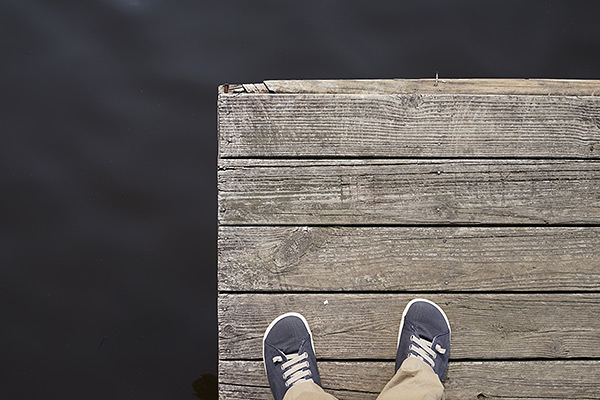 |
| Sony RX1R (above) |
In this shot, the differences are probably most readily apparent in the grain of the large knot above the person's left foot, and in the texture of their shoes and shoelaces. |
The following comparison shots prove that landscape photographers may want to consider choosing the RX1R over the RX1 -- especially if they prefer shooting JPEGs. In fact, Sony told us that landscape photographers were likely to be the No. 1 audience for the RX1R.
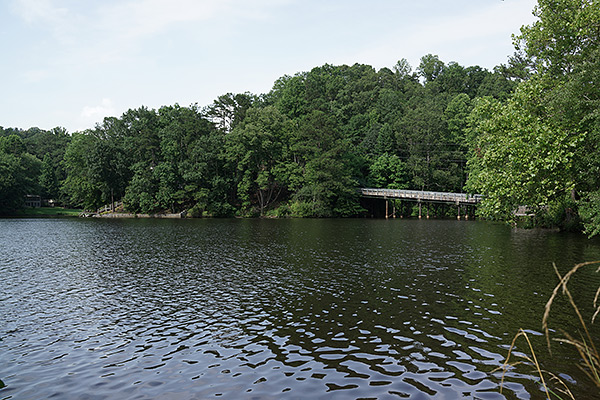 |
| Sony RX1 - JPEG |
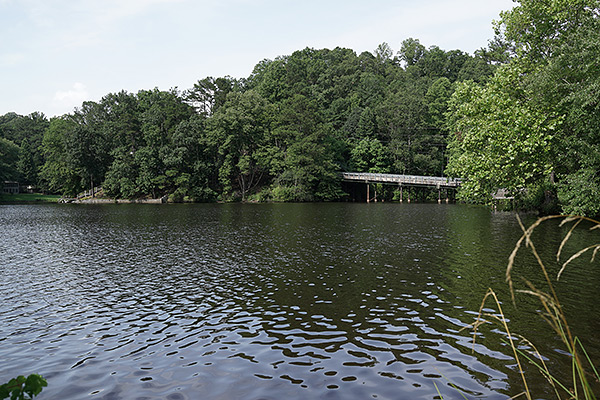 |
| Sony RX1R - JPEG |
The difference in sharpness between the two cameras is very evident in this shot. What's especially interesting here is the interaction between the removal of the low-pass and the (likely improved) noise-reduction processing in the rendering of some of the foliage. |
Here are a pair of 1:1 detailed crops of the above images that showcase the astonishing difference between the two cameras' JPEG images.
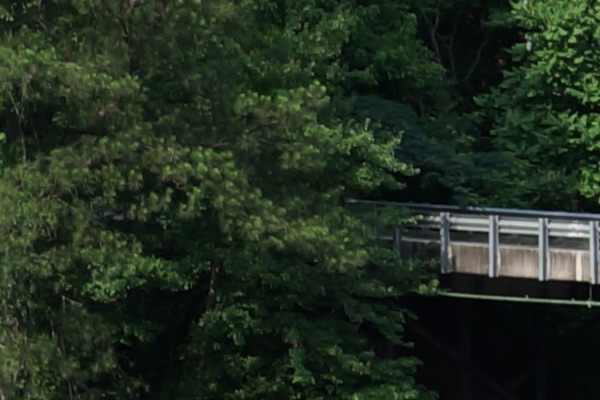 |
| Sony RX1 1:1 crop (above) |
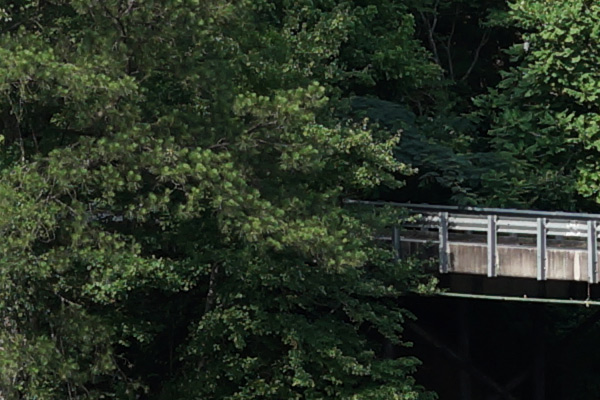 |
| Sony RX1R 1:1 crop (above) |
Now this is dramatic. Not only is the RX1R image very noticeably sharper, but there's radically more definition in the foliage, from highlights through shadows. |
The increased sharpness and definition in these shots can be attributed to improved JPEG production, but we think some of it is also the result of how the increased detail in the RX1R's images interacts with its noise-reduction algorithms.
We've seen this sort of thing very often in digicams that are limited by poor lenses: With lower amounts of fine subject detail in areas of subtle contrast, the noise reduction algorithms tend to assume that the remaining local tonal variations are probably noise, and further smudge what detail remains. There's no question of the lens limiting the RX1's performance here, but the effect of the low-pass filter could be much the same. With more fine detail arriving from the sensor, the RX1R's image processing trusts that what it's seeing is actual subject detail, and so refrains from flattening the foliage into impressionistic blobs.
A sharper camera is always nice, but conversely, the pair of shots below actually illustrate why it may not make as much difference as you'd think to many shooters. As noted earlier, the sharper the camera the shallower the effective depth of field for any given aperture. This means that for three-dimensional objects relatively close to the camera and at reasonable apertures, only a relatively small slice of your subject is going to be in focus enough to take advantage of all that resolution.
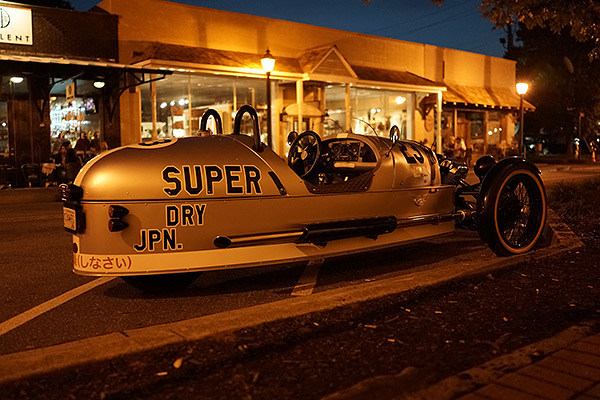 |
| Sony RX1 (above) |
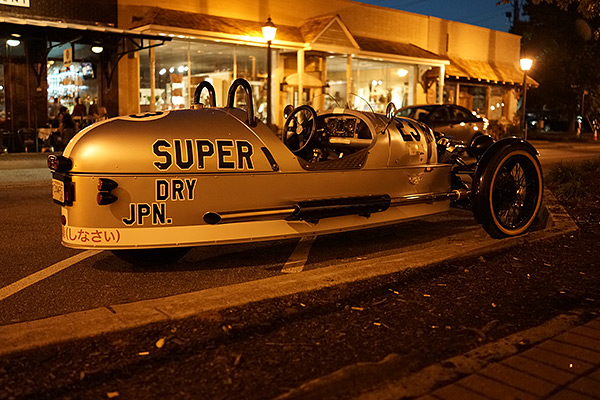 |
| Sony RX1R (above) |
These two images were shot as close to identically as we could manage, but it's tough to find parts of the car similarly in focus between the two. If you already have an RX1, you may want to think twice about the types of subjects you shoot before running out to trade it in for the RX1R. If a lot of your shots are like this (3D objects relatively close to the camera at wide apertures), you'll have to be awfully exacting to put the center of the DOF exactly where you want it, and the 90% or more of your image outside the now-smaller DOF won't gain any benefit from the added sharpness. |
The RAW deal. Given the obvious superiority of the RX1R's JPEG images, we were surprised that differences in the two cameras' RAW images were much more subtle. In fact, unless you're pixel-peeping to the extreme, it can be very difficult to see any appreciable increase in detail and sharpness in the RX1R images. In the table below, we examined the RAW versions of one of our still test shots from both cameras, running them through Adobe Camera Raw 8.2, and did not apply any sharpening or noise reduction.
In the second pass, we then applied an equal amount of sharpening in Photoshop using Unsharp Mask, with a radius of 0.3 and a strength of 350. In these comparisons, there is still a subtle yet noticeable increase in fine detail in the RX1R images, but nothing approaching what we saw in the JPEGs.
Image quality summary. Compared to the original RX1, the Sony RX1R was supposed to show a dramatic improvement in image sharpness and detail due to the removal of the optical low-pass filter. And the newer model definitely makes some dramatic gains when shooting JPEGs. However, we saw only subtle differences in RAW images. The RAWs from the RX1R only show a tiny bit more detail without any post-processing applied. Even with an equal helping of Unsharp Masking in Photoshop applied to the RAW images from both cameras, the RX1R still didn't demonstrate a significant advantage over the RX1 unless you pixel-peeped very closely.
Want our final verdict on the Sony RX1R? Still can't decide between it and the RX1? Read our full Sony RX1R review online to see which model is the right one for you: http://www.imaging-resource.com/PRODS/sony-rx1r/sony-rx1rA.HTM
-----------------------------------------------------------------------------------------------------
FEATURE: How to Get Your Photo Project Funded by Crowdsourcing on Kickstarter
-------------
by Vickey Williams
We've posted stories on a number of photo-centric Kickstarter campaigns on Imaging Resource in recent years, including this one for an inexpensive micro lens for smartphones. The brainchild of a Washington state mechanical engineering grad, we reported this summer the project breezed to its $5,000 goal. In fact, when the counting was done, Thomas Larson's idea had swept in more than 18 times that amount: $91,524.
Turns out Larson is a nice fellow and was kind enough to respond to our email inquiries this week about his experience with crowd funding, as did David Dyte, who just days ago saw the close of a successful photo book project on Kickstarter. An Australian who came to New York in 1999, Dyte watched his project more than triple its $3,000 goal. The book will showcase his photos of 56 neighborhoods that make up Brooklyn.

Photographer David Dyte, who recently saw his Kickstarter campaign for the photo book 'As Seen in Brooklyn' pull in more than $10,000 and more than triple his crowd-funding goal, offered a signed print of 'Nathan's at Coney Island 2013' for donors at the $25 level. A system of tiered rewards can grease the skids to prompt supporters to act. Photo by David Dyte
Kickstarter is one of hundreds of services available to help with crowdsourced fund raising. It lays claim to being the largest and distinguishes itself by focusing solely on creative works. As of this week, it had more than 100 projects in its photography category. Think photo books, sets of photo postcards, photography workshops for at-risk teens, photo exhibits, photo excursions. A Londoner hit pay dirt with an idea for a pop-up pinhole camera kit. The public can be generous.
Indiegogo is another big crowdfunding platform that this week also listed scores of photography-related appeals counting down to a deadline. Its guidelines are looser and some are extremely, even painfully, personal. For example, backers kindly bought in to helping underwrite time off for a photographer to be with his cancer-stricken wife. But more self-serving pleas to "help me upgrade my camera" or "underwrite my life while I pursue a dream of travel and photography" had attracted little funds when we checked.
How Kickstarter works
Kickstarter says its has learned a bit, hosting nearly 50,000 projects and helping creators raise $814 million since 2009. Its model in a nutshell, as spelled out in its guidelines and site articles: The project must truly be a project, with an end point and a deliverable that equates to success. Kickstarter gets 5% of the draw and there is an additional 3-5% assessed to cover credit-card fees. The creator sets the amount sought, and funding is all or nothing; if the goal isn't met, no one's credit card gets charged. Project deadlines are never longer than 60 days and, if desired, can be as short as one day.
Kickstarter urges creators to offer "rewards" as incentives to would-be backers, based on amounts committed. For example, someone seeking backing for a photo book might promise a signed postcard print for a supporter buying in for $5. Successively larger amounts might net the donor a mention on a supporters page in the book, a copy of the book, or dinner with the photographer. There is stern language about delivering on reward promises and keeping backers informed throughout the process with progress reports. Creators must specify deadlines for delivering their rewards.
Creators lucky enough to exceed their goal are encouraged to use the extra money to improve the project and share their good fortune by upgrading their rewards. And there's lots of advice on what tends to work.
Having recently achieved their funding goals, Larson and Dyte were both concentrating on making good on their rewards promises when we reached out to talk. Both also said the set up and follow-through can be more time-consuming than anticipated.
Sharing what they learned
In his pitch for support, Larson explained he'd been working on the micro lens for more than a year in his basement and at the University of Washington. (Kickstarter stresses evidence of progress on a plan is a big motivator for would-be funders.) The idea of a self-adhering, reusable add-on lens for smartphones proved irresistible for about 5,000 people, who took Larson up on his offer to receive one by mail for a commitment of at least US$12-$15.
Thomas Larson's successfully funded Kickstarter project financed manufacture of his Micro Phone Lens, designed to allow close-up photos on smartphones and tablets.
His Kickstarter boost was sufficient to enable him to dedicate himself full time to the work, he told IR, "This has been a successful enough endeavor that I will most certainly keep working on it."
There's been some interest from supporters who might be willing to back him beyond this project, Larson said, but nothing serious. For now he's planning to grow his company on his own though he hopes to be able to make a hire or two in the next few months.
"It's been a challenge, but also a great learning experience to be fulfilling such a large amount of orders," he sad. He has a couple of other ideas related to "cell phone microscopy," as he terms it, but his interests are diverse and extend beyond imaging. Next Kickstarter project for Larson: Something involving food.
The biggest headache of his crowd-funding campaign? "All the paperwork, definitely," he said. "When starting a business there are about 1,000 things you have to keep track of, and there isn't any central way to deal with them." While he says he's on target for making his deadlines to donors, next time he'll focus even more on organization and prep work, and cut himself more leeway on timing. His project closed Sept. 10, and his targeted delivery of the lens is the end of October.

Thomas Larson is a mechanical engineer living in Seattle who had worked on his lens project in college classes -- and on his own -- for a year before going public with his search for financing. He has additional ideas in mind, but for now he is focused on shipping the thousands of lenses purchased by his donors.
Like Larson, Dyte's project was well under way before he turned to the public for help. All the photos had been shot -- see his Picasa gallery -- and he had designer partner Lucia Reed lined up to help. As Kickstarter encouraged, the funds exceeding his goal will help him improve the project, taking the book from a planned 130 pages to 150. But there's really no overage, he said.
"The cost of all of those rewards will eat up the $10K," Dyte told us. "The price we offered on the actual book is less than it will cost to print, per copy, even with the discount for so many orders."
He's feeling a bit "in the weeds" these days, what with compiling the book and prepping for his promised delivery in December, but says he hopes to do more photo projects. "This has been too much fun not to try again."
David Dyte scouts shots in the Parkville neighborhood. Photo by David Dyte
Like Larson, Dyte cites "Getting set up in business mode" as the biggest challenge to the Kickstarter experience. He said he lucked out on estimating price and demand. "My advice to others would be not to let the red tape get you down," Dyte said. "I had my moments of thinking this would be dead before it even started, but everything sorted itself out eventually with a little persistence and encouragement from family and friends."
Mashable has devoted a number of posts to the topic of crowdfunding aimed at helping people select the right platform.
-----------------------------------------------------------------------------------------------------
CAMERA PREVIEW ROUNDUP
---------------------------------------
Pentax K-3 review: First impressions of a truly revolutionary update
by Mike Tomkins
Since the launch of the K-7 in 2009, Pentax's flagship, enthusiast-grade�APS-C DSLRs have been among our favorites. After a couple of evolutionary models, the brand-new Pentax K-3 has arrived, and it's a revolution in the making. Not only does the K-3 bring significant changes inside and out, it also includes an industry first. The K-3 is the only SLR to feature on-demand low-pass filtering, which lets you choose whether ultimate resolution or resistance to moir� are more important for any given shot.
And there's plenty else besides that makes the Pentax K-3 an exciting upgrade, including a brand-new body that retains the spirit of the design first introduced with the K-7, yet makes significant changes to the controls for the first time in several generations. The 24.3-megapixel Pentax K-3 also sports significantly higher resolution, and yet thanks to a new PRIME III image processor, shoots faster and longer than ever -- a whopping 8.3 frames per second for as many as 60 frames. And despite the significant resolution increase, the K-3 still offers a maximum sensitivity of ISO 51,200 equivalent.
Read our full first impressions review here: http://www.imaging-resource.com/PRODS/pentax-k3/pentax-k3A.HTM
-----------------------------------------------------------------------------------------------------
A Photo Geek's Guide to Pentax's 'switchable' low-pass filter
by Dave Etchells
We don't normally post a separate news story when a new camera model brings a new technology along with it, but Pentax's new mechanical anti-aliasing filter simulator is so revolutionary that it more than deserves special mention. For the first time, a camera exists that lets you choose whether you want a low-pass filter in your optical chain or not. This is huge.
There's always been an uncomfortable trade-off in digital imaging between image detail and image artifacts; crank up the detail, and moir� patterns and color artifacts will follow right behind. Crank down the artifacts, and your images will appear soft and mushy as well. It's the job of the anti-aliasing filter (also called a low-pass filter or LPF) to manage this trade-off. Choosing just the right strength filter is a fine art, and greatly subject to personal preference.
Read more about this groundbreaking new technology here: http://www.imaging-resource.com/PRODS/pentax-k3/pentax-k3A.HTM#pentaxaa
-----------------------------------------------------------------------------------------------------
Nikon D610 hands-on preview: Full-frame DSLR gets new shutter, and a fix for D600's oil issue
by Roger Slavens
Last fall, Nikon made full-frame photography more affordable than ever with the introduction of the D600 prosumer DSLR. And now the company is back one year later with a slightly updated model -- the Nikon D610 -- featuring a new shutter mechanism that not only promises to boost the camera's continuous shooting speed, but also should eliminate the persistent oil-on-sensor problem that marred the D600's otherwise high quality images.
Boasting the same 24.3-megapixel FX CMOS sensor, optical viewfinder with 100% coverage and 3.2-inch, 921K-dot LCD monitor as its predecessor, the D610 also features a new quiet continuous shutter mode and improved white balance. But arguably the best feature is that the Nikon D610 is priced $100 cheaper at launch than the D600, available in late October for US$2,000 body only or US$2,600 paired with the AF-S NIKKOR 24-85mm lens.
Read our hands-on Nikon D610 preview for more details: http://www.imaging-resource.com/PRODS/nikon-d610/nikon-d610A.HTM
-----------------------------------------------------------------------------------------------------
Sony A7 and A7R reviews: First impressions of the world's first full-frame mirrorless ILCs
by Mike Tomkins
Life is all about compromises, but fans of full-frame and mirrorless cameras will be thrilled to hear that Sony has just removed a compromise we've long taken as an unfortunate fact of life. If you wanted a mirrorless camera, you had to live with -- at best -- an APS-C sensor. If you wanted a full-frame sensor, it had to come along with a bulky mirror box. There was no middle ground -- at least, not until now. With the simultaneously-launched, full-frame Sony A7 and Sony A7R mirrorless cameras, the company has demolished the status quo.
The two cameras are very closely-related, with the Sony A7R being the higher-resolution of the two models -- and we do mean high-res. While its sibling isn't exactly a slouch in terms of resolution, the 36.4-megapixel Sony A7R matches Nikon's impressive D800 and D800E for pure sensor resolution, yet with a much smaller, mirrorless body. It does have some disadvantages compared to the lower-res (still 24.3-megapixel!) A7 in other areas, though. If shooting performance is more important to you than resolution, you'll want to take a look at the Sony A7 instead.
We were able to spend some significant hands-on time with pre-production samples of both full-frame mirrorless cameras, and IR publisher Dave Etchells weighs in on their impressive technologies, as well as his first impressions handling and shooting with them.
Read our first impressions Sony A7 review here: http://www.imaging-resource.com/camera-reviews/sony/a7/
And our first impressions Sony A7R review here: http://www.imaging-resource.com/camera-reviews/sony/a7r/
-----------------------------------------------------------------------------------------------------
Sony RX10 hands-on preview: Could this be the ultimate bridge camera?
by Mike Tomkins
Once a popular category, the market for enthusiast-grade, all-in-one cameras (aka "bridge" cameras) has been a little moribund in recent years, but the new Sony RX10 promises to breathe new life into the high end of the field. While there's been a steady stream of new bridge-camera models, increasingly compact and affordable mirrorless interchangeable-lens cameras have squeezed the category unmercifully, making it harder to justify spending $500 to $600 on what's basically just a small-sensor camera. Canon upped the ante some in early 2012 by introducing their G1X, bringing a near APS-C sized sensor, and a price point of $800 to the fray. It was a very capable camera, but some found its 4x zoom range a little limiting, and the maximum aperture at the tele end was only f/5.8.
Now comes the Sony RX10, using the same (excellent) 1-inch type sensor as the RX100 II, but this time adding a constant aperture f/2.8, 8x zoom lens with a 35mm-equivalent range of 24-200mm. That's just the very tip of the iceberg of goodness, though. The Sony RX10's feature list is pretty eye-popping, including superior EVF optics, an new and super-fast AF system, unlimited 10 frames per second direct-to-card shooting with full autofocus tracking, and exceptional video capabilities.
Read our hands-on, first impressions Sony RX10 review here: http://www.imaging-resource.com/camera-reviews/sony/rx10/
-----------------------------------------------------------------------------------------------------
Nikon D5300 review: Initial look at Nikon's latest consumer DSLR with ramped-up resolution
by Roger Slavens
The Nikon D5300 may mark an evolutionary -- rather than a revolutionary -- upgrade over the less-than-one-year-old D5200. However, the camera's improvements are quite considerable, potentially positioning the DSLR as a compelling, more affordable option for advanced amateurs who may be eyeing the higher-end, prosumer D7100, as well enticing owners of Nikon's consumer-level DSLRs to take a step up. The most noticeable enhancement appears to be the D5300's built-in Wi-Fi functionality, which makes it the first Nikon DSLR that doesn't rely on an accessory dongle (WU-1a/b) to share images wirelessly or provide remote control capture when paired with smart devices. The D5300 is also the first Nikon DSLR to feature built-in GPS.
In addition to its Wi-Fi savviness, the Nikon D5300 holds a few other advantages over its predecessor, the D5200, and in many instances rivals the D7100. For one, the D5300's enhanced DX-format, 24-megapixel APS-C-type CMOS sensor should help maximize the camera's resolving power by omitting the optical low-pass filter (as Nikon did earlier with the D7100). If the D5300 can minimize moir� and anti-aliasing as well as the D7100 did, forgoing the OLPF in a consumer-friendly DSLR could be the move that opens up a realm of incredible detail and sharpness to a mass audience.
Read our first impressions Nikon D5300 review here: http://www.imaging-resource.com/PRODS/nikon-d5300/nikon-d5300A.HTM
-----------------------------------------------------------------------------------------------------
Panasonic GM1 review: This truly 'micro' Micro Four Thirds camera took us by surprise
by William Brawley
Panasonic has introduced the first truly "micro" Micro Four Thirds camera with its diminutive yet powerful Panasonic GM1 -- the latest addition to the company's already healthy lineup of mirrorless cameras.�If you�re a photographer who wants a camera in the size of a point-and-shoot, but with the flexibility and larger sensor of an interchangeable lens camera, then the Panasonic GM1 might just be the camera for you.
The GM1 is no slouch as it shares the stage with its bigger brother, the Panasonic GX7. In fact, the GM1 packs in almost all of the same imaging capabilities, with just a few compromises to accommodate its small size, namely the lack of an electronic viewfinder and an articulated LCD monitor. The Panasonic GM1 and GX7 share the same 16-megapixel Live-MOS sensor, Venus Engine image processor, fast autofocusing capabilities and expanded sensitivity up to ISO 25,600. The manufacturer claims the GM1 -- for all intents and purposes -- produces the same image and video quality as the GX7.
In our hands-on, first impressions review of the camera, IR publisher Dave Etchells goes in-depth with a look at some of the GM1's most technologically innovative features, such as its new shutter design and magnesium allow construction. He also touches on the technical reasoning behind some of the minor trade-offs that had to be made to produce such a small yet powerful interchangeable lens camera.
Read our hands-on first impressions Panasonic GM1 review here: http://www.imaging-resource.com/PRODS/panasonic-gm1/panasonic-gm1A.HTM
-----------------------------------------------------------------------------------------------------
WE'VE GOT MAIL: Questions from readers, answers from IR
-----------------------
Please send us your camera and photography questions and comments (editor@imaging-resource.com). Not only will we respond to each and every one of your letters, but we'll also publish the best ones here as a resource for all our readers.
Point-and-shoot coverage
Dave --
Further to your recent correspondence with Terry regarding coverage of point and shoots, I'm in agreement with him. I just bought a Sony DSC WX 300, mainly for its compact size and versatile features (not found on smart phones). There was very little research information online compared to DSLR sources.
I don't intend to buy a DSLR or any interchangeable lens camera in the future, so the sites that focus on these are increasingly useless to me.
Terry W.
---------------------
Hi Terry --
Thanks for the note and encouragement to do more with point and shoots. We're looking further at the roundup format, trying to think how to make production of it more manageable. We're just about to post our waterproof roundup -- in October. So far, each of the three "roundup" articles we've done has ended up taking waaaay more time than we can afford.
I'm curious, though, since you're the sort of reader these would be aimed at. What would you consider the minimum useful information that would help you make a decision? What was it that made you decide on the WX300? If we can efficiently answer the questions most people are interested in, and not waste time on evaluating things that people don't care about, it might help make the roundup format more manageable for us. Thanks for the input! (Other readers please feel free to chime in on this topic, too!)
-- Dave
-----------------------------------------------------------------------------------------------------
Leicas! (Part One)
Dave --
I really appreciate the Comparometer and wouldn't think of buying a camera without doing comparisons by opening the comparometer twice and having the two windows open side by side on my screen.
But I am puzzled why you don't have the Leica X2 on the site (or indeed the X1 and the X Vario). I wanted to do a comparison with the Ricoh GR and can't.
I should be grateful for your response. I follow your site regularly with much enjoyment and appreciation.
John Nicholson, Denmark
---------------------
Hi John --
Our dilemma is that there are always more cameras out there than we can manage to get reviews up for. So we have to pick our shots, and tend to only review cameras that will account for large numbers of retail sales, therefore of interest to the maximum number of readers. That said, Leica has a very loyal fan base, and cameras like the X2 are bringing the Leica brand down into the price range of other high-end fixed-lens models.
We can't possibly do full reviews on every camera out there, but we're looking into a super-short format that would let us get basic sample images and information on image quality up quickly, and provide basic shots (probably just Still Life and VFA) into the Comparometer for a lot more cameras than currently. The Leica X2 could be a candidate for that sort of treatment.
-- Dave
-----------------------------------------------------------------------------------------------------
Leicas! (Part Two)
Dave --
When will you at least complete the studio shoot for the Leica X Vario? Will you be completing a review? Thank you!
John Griffith
---------------------
Hi John --
Ha! See my answer to John from Denmark above :-) But I've got good news for you. We're actually going to be getting an X Vario in here for a super-quick shoot and posting sometime in the next week or two. It won't be a full review, but we'll have an opinion piece by IR contributor Jason Schneider to post with the test shots. Jason thinks people have the X Vario pegged wrong, that many just don't get what the camera's about. It should be an interesting article, stay tuned.
-- Dave
-----------------------------------------------------------------------------------------------------
Canon 70D Review
IR team --
Just wanted to thank you for such a comprehensive review of the camera. I bought it because of your video coverage. I plan to use the 70D primarily for video shooting. One thing I did notice on this new camera is that, during post, the audio is on sync compared to previous cameras like the Canon T2i, 60D, 5D Mark III. That saves a lot of shifting two frames back with audio to get a perfect sync.
�
Thanks,
Johnny Wu
---------------------
Hi Johnny --
Thanks for the kudos on our 70D review. Yeah, it seemed like a real breakthrough for video and live focusing, hence the amount of effort we put into explaining it. Thanks, too, for sharing that info about the audio sync. That's something we don't test, but it's obviously a big convenience factor when it comes to editing. We'll add a note to the video page of our review, sharing that info with our readers, and crediting you as the source. Thanks again for taking time to write and share that with us and our readers!
Glad the review was useful to you, thanks again for the kudos!
-- Dave E.
-----------------------------------------------------------------------------------------------------
Panasonic GM1 first impressions
Dave and IR Team --
Thanks for the usual good article about the Panasonic GM1.
You wrote: "When I was first briefed on the Micro Four Thirds (MFT) concept in Japan several years ago, I was expecting some seriously small cameras, but the actual products turned out to be not all that small."
My thoughts exactly. But what’s with the Panasonic GH3? Despite space for electronics, I’m still a bit disappointed that the ratio of film/sensor size to body size is still not close to what film cameras could accomplish. (Though the past couple of days have made big strides with Sony and Panasonic.)
By the way, I’m puzzled a little by the normal lenses sticking outside the mount. I'm not sure about that, since from the pictures, the outer and inner edge (the latter must be fixed size of course) have the same relationship (0.73) as it has on my Micro Four Thirds cameras.
Warm regards,
Eolake
---------------------
Hi Eolake --
Yeah, right?
I'm not sure, but I think some of the size issue with the GH3 is simply to have enough volume/surface area to dissipate the heat from 60p video and the very high bitrate recording it can do, and to safely do so over a wide range of operating temperatures. As we're seeing with the GM1, the issue with miniaturization isn't so much component size, as what you do with the heat generated. (The GM1 disables 60p video and bulb exposures simply because the tiny body would heat up too much if those features were used.)
On the lenses, I perhaps should have qualified the statement by saying "some conventional MFT lenses." The flange is indeed identical to that on other MFT cameras, but I think some standard MFT lenses overhang the flange some, while others don't. Actually... went back to our first impressions review and it looks like someone actually took care of that: the text currently refers to just "some larger lenses. It's just some lenses that project beyond the mounting flange, many do not.
-- Dave
----------------------------------------------------------------------------------------------------
NEXT ISSUE
---------------
Our next issue will be mailed to you in two weeks on Friday, November 1. See you then!
SIGNOFF
-----------
That's it for now, but between issues visit our site for the latest news, reviews, or to have your questions answered in our free discussion forum. Here are the links to our most popular pages:
Newsletter Archive: http://www.imaging-resource.com/cgi-bin/dada-nltr/mail.cgi/archive/irnews
Daily News: http://www.imaging-resource.com/news
SLR Gear: http://www.slrgear.com
New on Site: http://www.imaging-resource.com/new-on-ir
Review Index: http://www.imaging-resource.com/camera-reviews
IR Photo Contest: http://www.dailydigitalphoto.com
Google + http://plus.google.com/+imagingresource
Facebook: http://www.facebook.com/imagingresource
Twitter: http://www.twitter.com/IR_Lab
Happy snapping!
Dave Etchells and Roger Slavens
editor@imaging-resource.com
| 








